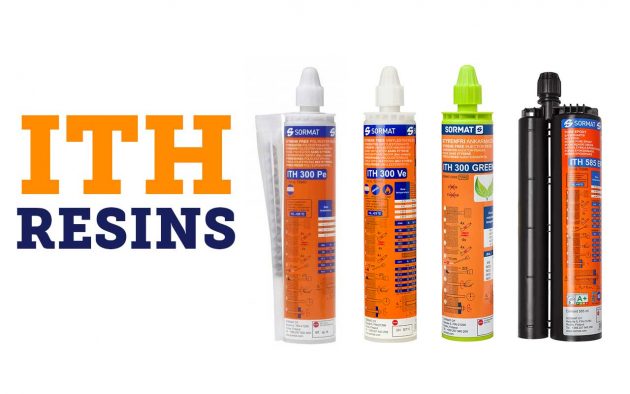Fixing school: Compound Manual
resin
How to use injection resins?
The Compound Manual, published by the Finnish company Sormat, helps in starting a new compound season. Now, there is no reason to use featherweight fastenings where a robust compound is required!
Injection resins, sealing materials, chemical anchors, glue anchors … fixings which are based on a chemical reaction are called by many names. Compounds are sold in cartridges of varying volumes. The most common cartridge size is 300 ml, which corresponds to the size of silicone and acrylic compound cartridges sold at all hardware stores.
Use our resin calcultor to estimate the consumption
CHEMICAL FASTENING IS COMPRISED OF COMPOUND AND METAL ANCHOR
Compound cartridges usually contain two separated substances, a hardener and a resin. The two-component compound is squeezed out of the cartridge using a dispenser. The components are mixed when they are squeezed out of the cartridge in a mixing nozzle (or mixing tube, mixer). In addition to the chemical, chemical anchoring requires the actual anchor, or a metal threaded rod, stud or bolt that is turned into the drilled hole after the compound within the curing time.
- Stud
- Threaded rod
- Rebar
- Eye bolt
Possible metal anchors for use with a compound also include inner threaded sleeve anchors, rebar in grips, column shoe in erecting fence posts, eye bolts in fastening piers to rock, etc. Completely smooth steel has a weaker adherence, so the fastened metal anchor must always have threads, nodules or other such adhesion surface.
In perforated and hollow adhesion bases, such as perforated bricks and hollow blocks, a hollow casing should be used for controlling the consumption of the compound.
DRILL, CLEAN, TIGHTEN – ROTATE, HARDEN, FIX!
The truth is the majority of failures in fixing is due to installation errors so some fundamental rules should be followed in chemical fixing:
· Incomplete cleaning of the drilled hole can decrease the performance of the injected compound by up to 50%! The best way to clean the drilled hole is to use a brush and an air pump designed for the task. If these are not available, you can use a bottle brush and a piece of hose or straw suitable for the drilled hole. Be careful not to blow dust into your face! If you have a heavy-duty vacuum cleaner suited for concrete dust, you can also tape an additional ISL mixing nozzleand, if necessary, also an EXT extension, to the end of the hose and vacuum the hole clean. Another good trick is a few puffs with an air compressor. However, never forget to brush the drilled hole to also remove dust from the walls and not only its bottom.
- First, air pumping or vacuum cleaning…
- …then brushing
- …and once again air pumping or vacuum cleaning!
· Anchoring compounds are comprised of two components only mixed in the mixing nozzle. Always before use, check that the compounds coming from the mixing nozzle are single-colour and fully mixed. Take a piece of cardboard and extrude the compound onto it until a fully single-colour substance comes out of the mixing nozzle. If the two components have not mixed correctly, the compound will not harden!
- If necessary, cut the bag open with scissors before use.
- A normal silicone extraction tool of good quality is adequate for Sormat’s 165, 300 and 280 ml cartridges.
- The compound is not mixed until the mixing nozzle.
· In solid construction materials, fill the hole 2/3 full. If you have drilled several holes, do not fill more than a couple of holes at a time. Otherwise, the compound might cure before you have the time to rotate the metal anchor into it. The curing time is usually just a couple of minutes when used indoors at normal room temperatures.
· Always install the metal anchor in the hole by rotating it.
· Do not begin to clean the excess compound while it is still wet! That will only make a mess. Wait for the compound to cure and then chisel the additional compound away with a hammer and a straight blade screwdriver, for example.
- In solid construction materials, fill the hole 2/3 full
- Always rotate the stud, threaded bar, etc., into the compound.
- Allow the compound to cure before removing the excess compound.
· You don’t have to use the entire cartridge at one time, just replace the mixing nozzle with a new one between uses! Leave the nozzle in place. It acts as a replacement for the cap during storage and preserves the compound for later use. Remember to check that the compound is mixed whenever you have replaced the nozzle before the next use!
· Anchoring compounds have a specific shelf life, after which the properties of the product begin to weaken. Compounds always carry a marking of EXP. DATE (month and year), after which the product is no longer recommended for use. The product is always best stored in a dry and cool place, never exposed to direct sunlight.
- Store an opened cartridge with the nozzle in place.
- Before the next use, simply replace the nozzle.
· Chemical anchoring compounds can be used in all rock-based construction materials. The suitability of an individual compound type for the conditions and construction materials in question should always be checked from the manufacturer’s instructions; the label often also indicates the suitable uses. In this video, a beam clamp is fixed to a LECA block using an anchoring compound.
![]()
More videos can be found on our YouTube channel youtube.com/sormatfixing. If you have a difficult fixing problem, you can always contact our fixing experts using our inquiry form. The solution for fixing problems is sormat.com!
























